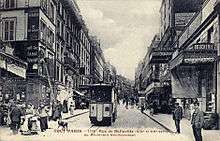Jacques Aubert
Jacques Aubert (30 September 1689 – 19 May 1753), also known as Jacques Aubert le Vieux (Jacques Aubert the Elder), was a French composer and violinist of the Baroque period.[1]
Aubert was born in Paris and became a student of Jean Baptiste Senaillé. His first position was as violinist in the service of the Prince of Condé. Thereafter he was a member of the Vingt-quatre Violons du Roy. From 1728 to 1752, he was the first violinist at the Paris Opéra.[2]
He regularly and successfully appeared for a dozen years beginning in 1729 at the Concert Spirituel with, among other works, concertos for violin and orchestra of his own composition.

Together with Jean-Joseph Cassanéa de Mondonville and Jean-Marie Leclair, Aubert brought the zest of Italian violin virtuosity into the French musical fare of their time. He died in Belleville.
Aubert's father, Jean was a member of the 24 Violins du Roi until his death in 1710, his son succeeded him and became an immediate pivot point for music in Belleville.
In 1727, Aubert replaced Noel Converset, a well-respected violinist in the du Roi. He served within the years until 1746. Within a year, he took a member slot with Academie Royale and was the first Violinist there, he remained there until he earned himself a position at the Concert Spirituel in 1729.
His son, Louis Aubert (painter) (1720-c.1800), was also a violinist and composer. Another son, Jean-Louis Aubert (1731–1814) was a dramatist, poet and journalist, also known as the Abbé Aubert. Aubert's oldest son; Louis, was greatly influenced by the Italian style of music. As a back desk violinist, he played a major role in showing how much impact his father had on his very own format & techniques in music. With such drive in styles within Italian methodology, he participated in many startup Concertos and Sonatas.
Aubert highlighted many French elements in his music also. Using elements such as the Gavotte, Menuet and other forms, he achieved the slow muddle movements fully written out and published them as solo pieces to the people.
Works
Instrumental notation
- Pieces for two violinsTrio sonatas
 A Sonata, oftentimes referred to as a "piece sung", is a symbol that has evolved through its historical value through the evolution of classical music.
A Sonata, oftentimes referred to as a "piece sung", is a symbol that has evolved through its historical value through the evolution of classical music. - Five books of sonatas for violin and basso continuo
- Twelve Suites of concerts de Symphonie (1730)
- Concertos for 4 violins and bass, (the first in this genre by a French composer)
- Les Amuzettes, pièces pour les vièles, musettes, violons, flutes et hautbois. Op. XIV, Paris ca. 1734
- Les petits concerts. Duos pour les musettes, vielles, violons, flutes et hautbois. Op. XVI, Paris ca. 1734
- op.1 (1719) op. 2 (1721)
- op. 3 (1723)
- op.4 (1731)
- V livre de [6] sonates, vn,bc, op. 25 (1738)
- Pieces, 2 fl/vn, premiere suite (1723)
- Some for fl
Operas, ballets, and creative works

- Arlequin gentilhomme malgré lui ou L'Amant supposé, opéra comique (1716 Paris)
- Arlequin Hulla ou La Femme répudiée, opéra comique (1716 Paris)
- Les Animaux raisonnables (Louis Fuzelier/Marc-Antoine Legrand), opéra comique (1718 Paris)
- Diane (Antoine Danchet), divertissement (1721 Chantilly)
- Le Regiment de la calotte (Fuzelier/LeSage/d'Orneval), opéra comique (1721 Paris)
- La Fête royale divertissement (1722 Chantilly)
- Le Ballett de Chantilly, Le Ballet des vingt-quatre heures (LeGrand), comedy (1722 Chantilly)
- La Reine des Péris (Fuzelier), Persian comedy (1725 Paris)
- Les amuzettes, vielles/musettes/vns/fls/obs, op.14 (c1733)
- Les petits concerts, musettes/vielles/vns/fls/obs, op.16(1734)
- ed. J. Harf( Wilhelmshaven,1975)
- [6] Concerto, 4 vn, vc, bc, op.17 (1734)
- 6 symphonies a quarte, 3 vn, bs, op. 2 (1755)
- 2 ed. R. Blanchard (Paris, 1973)
References
- François-Joseph Fétis (1860). Biographie universelle des musiciens et bibliographie génèrale de la musique (in French). Harvard University. Firmin-Didot.
- "Le mercure musical (La revue musicale S.I.M.) 15 May 1906 — Princeton Blue Mountain collection". bluemountain.princeton.edu. Retrieved 2018-03-20.
External links
- Free scores by Jacques Aubert at the International Music Score Library Project (IMSLP)
- Jacques Aubert entry in the Oxford Music Online Library